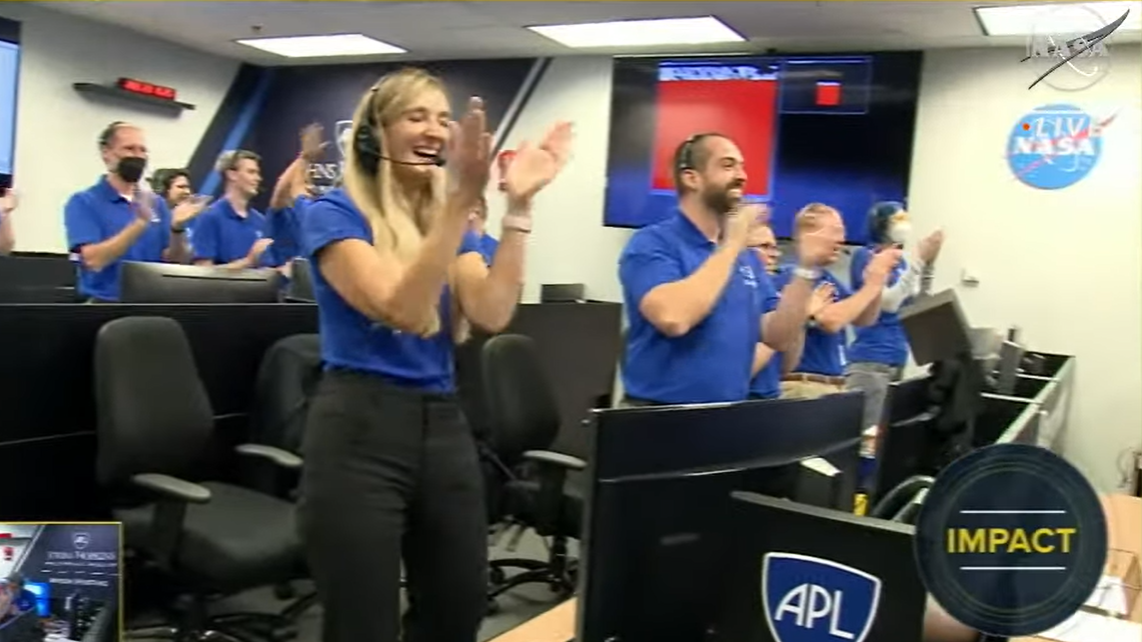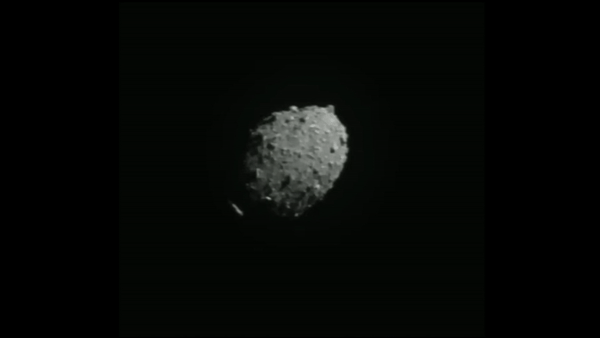'Terror and joy': NASA's DART asteroid impact a historic success (and relief)
It was a very emotional day for the DART team.

It's rare for spacecraft mission personnel to cheer at the words "loss of signal," but tonight, that's exactly what happened.
Team members are celebrating the successful impact of NASA's Double Asteroid Redirection Test (DART), which slammed into an asteroid called Dimorphos Monday night (Sept. 26) at 7:14 p.m. EDT (2314 GMT) as planned. The mission was designed to evaluate a potential method of planetary defense so that, if astronomers ever spot a large asteroid that might collide with Earth, humans might be able to avoid the catastrophe. Although the team will need days or possibly weeks to evaluate just how successful DART's test was, simply hitting Dimorphos was a massive achievement, they said.
"Definitely as we were getting close to the asteroid, there was a lot of — Ed [Reynolds, DART program manager] said joy, I say both terror and joy at the same time," Elena Adams, DART's mission systems engineer, said during a news conference held about an hour after impact.
Related: Asteroid impact: Here's the last thing NASA's DART spacecraft saw before it crashed
"This asteroid was coming into the field of view for the first time," Adams said. "We really had no idea what to expect. We didn't really know the shape of the asteroid, but we knew we were going to hit. So I think all of us were kind of holding our breath. I'm kind of surprised none of us passed out, actually."
The team members also confirmed that DART operators didn't have to intervene at all during the final four hours of DART's approach. "This mission was straight down the middle of what our expectations were, and there were no adjustments needed," Mark Jensenius, DART Smart Nav guidance engineer at the Johns Hopkins University Applied Physics Laboratory (JHUAPL), which operates the DART mission for NASA, said during the news conference.
"It was actually kind of disappointing," Adams said. "We prepared these 21 contingencies and then we did none of them."
Get the Space.com Newsletter
Breaking space news, the latest updates on rocket launches, skywatching events and more!
DART's final measure of success will come in the next weeks and months, as scientists evaluate just how much the impact changed the orbit of Dimorphos around its larger parent asteroid, Didymos. But the team isn't concerned.
"As far as we can tell, our first planetary defense test was a success," Adams said. "Yeah, I think Earthlings should sleep better. Definitely I will." Planetary defense is dedicated to spotting asteroids that could potentially hit Earth and, if necessary, attempting to adjust the space rock's orbit enough to avoid catastrophe.
Right now, NASA doesn't know of any large asteroids that might hit Earth within the coming decades, but scientists are constantly scanning the skies to identify and track space rocks. DART marks the first step in moving beyond simply watching asteroids and considering actively intervening in their orbits.
"It is absolutely wonderful to do something this amazing, and we are so excited to be done," Adams said. "To see it so beautifully concluded today was just an incredible feeling."

For the spacecraft team, today marks the beginning of the end, but for scientists involved in the mission, there's a lot more to do.
"These guys, their job is done, but ours is just beginning," Carolyn Ernst, instrument scientist for DART's DRACO camera and a planetary scientist at JHUAPL, said during the news conference. "We'll spend the next months and years doing analysis, of course. Our job has just started, but it really looks just amazing."
Although the DART spacecraft itself is in no shape to report home, scientists do have some more data to look forward to. Over the coming days, a small satellite called Light Italian Cubesat for Imaging Asteroids (LICIACube) that DART deployed earlier this month will send to Earth a host of images captured just three minutes after the impact.
Meanwhile, scientists will also use ground-based observatories to clock the orbit of Dimorphos around Didymos. That orbit used to take 11 hours and 55 minutes, but scientists estimate that tonight's impact should cut that by at least 73 seconds, and perhaps more like 10 minutes. That full, detailed process will take perhaps two months, Adams said.
That's not the end of humanity's interest in Dimorphos, however. In 2024, the European Space Agency will launch the Hera mission, which will explore the binary asteroid system in detail beginning in December 2026. That spacecraft carries two additional cubesats that will be able to approach the asteroids more closely than Hera itself dares.
All told, the five spacecraft make for an impressive team showcasing human efforts to avoid going the way of the dinosaurs.
"We're embarking on a new era of humankind," Lori Glaze, who leads NASA's planetary science division, said during NASA's live broadcast shortly after impact. "An era in which we potentially have the capability to protect ourselves from something like a dangerous, hazardous asteroid impact. What an amazing thing. We've never had that capability before."
Email Meghan Bartels at mbartels@space.com or follow her on Twitter @meghanbartels. Follow us on Twitter @Spacedotcom and on Facebook.
Join our Space Forums to keep talking space on the latest missions, night sky and more! And if you have a news tip, correction or comment, let us know at: community@space.com.

Meghan is a senior writer at Space.com and has more than five years' experience as a science journalist based in New York City. She joined Space.com in July 2018, with previous writing published in outlets including Newsweek and Audubon. Meghan earned an MA in science journalism from New York University and a BA in classics from Georgetown University, and in her free time she enjoys reading and visiting museums. Follow her on Twitter at @meghanbartels.









